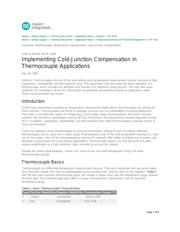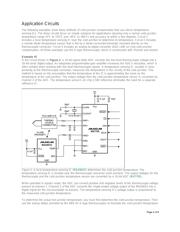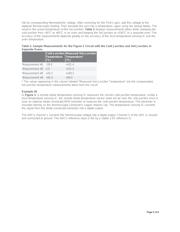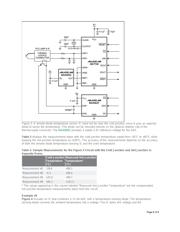下载

Maxim > Design Support > Technical Documents > Application Notes > Sensors > APP 4026
Maxim > Design Support > Technical Documents > Application Notes > Temperature Sensors and Thermal Management > APP 4026
Keywords: thermocouple, temperature measurement, cold junction compensation
APPLICATION NOTE 4026
Implementing Cold-Junction Compensation in
Thermocouple Applications
Apr 26, 2007
Abstract:
Thermocouples are
one of the most widely used temperature-measurement devices because of their
ruggedness, repeatability, and fast response time. This application note discusses the basic operation of a
thermocouple, which includes the definition and function of a reference (cold) junction. The note also gives
guidelines for selecting a device for cold-junction temperature measurement based on application needs.
Three circuit examples are shown.
Introduction
Of the many transducers available for temperature-measurement applications, thermocouples are among the
most common. Thermocouples are found in everyday systems such as automobiles and home appliances.
They offer a cost-effective means for measuring a much wider range of temperatures than other common
solutions like resistance temperature devices (RTDs), thermistors, and temperature-sensing integrated circuits
(ICs). In addition, ruggedness, repeatability, and fast response time make thermocouples a popular choice in
many environments.
There are, however, some disadvantages to using thermocouples, notably its lack of linearity. Although
thermocouples can be used over a wider range of temperatures than RTDs and temperature-sensing ICs, they
are far less linear. Also, RTDs and temperature-sensing ICs typically offer better sensitivity and accuracy, two
desirable characteristics for more precise applications. Thermocouple signals are very low-level and often
require amplification or a high-resolution data converter to process the signals.
Despite the above disadvantages, overall cost, ease of use, and wide temperature range still make
thermocouples popular.
Thermocouple Basics
Thermocouples are differential temperature-measurement devices. They are constructed with two wires made
from dissimilar metals. One wire is predesignated as the positive side, and the other as the negative. Table 1
lists the four most common thermocouple types, the metals or alloys used, and the temperature range allowed
for each type. Each thermocouple type offers a unique thermoelectric characteristic over its specified
temperature range.
Table 1. Basic Thermocouple Characteristics
Type Positive Metal/Alloy Negative Metal/Alloy Temperature Range (°C)
T Copper Constantan -200 to +350
J Iron Constantan 0 to +750
Page 1 of 8








